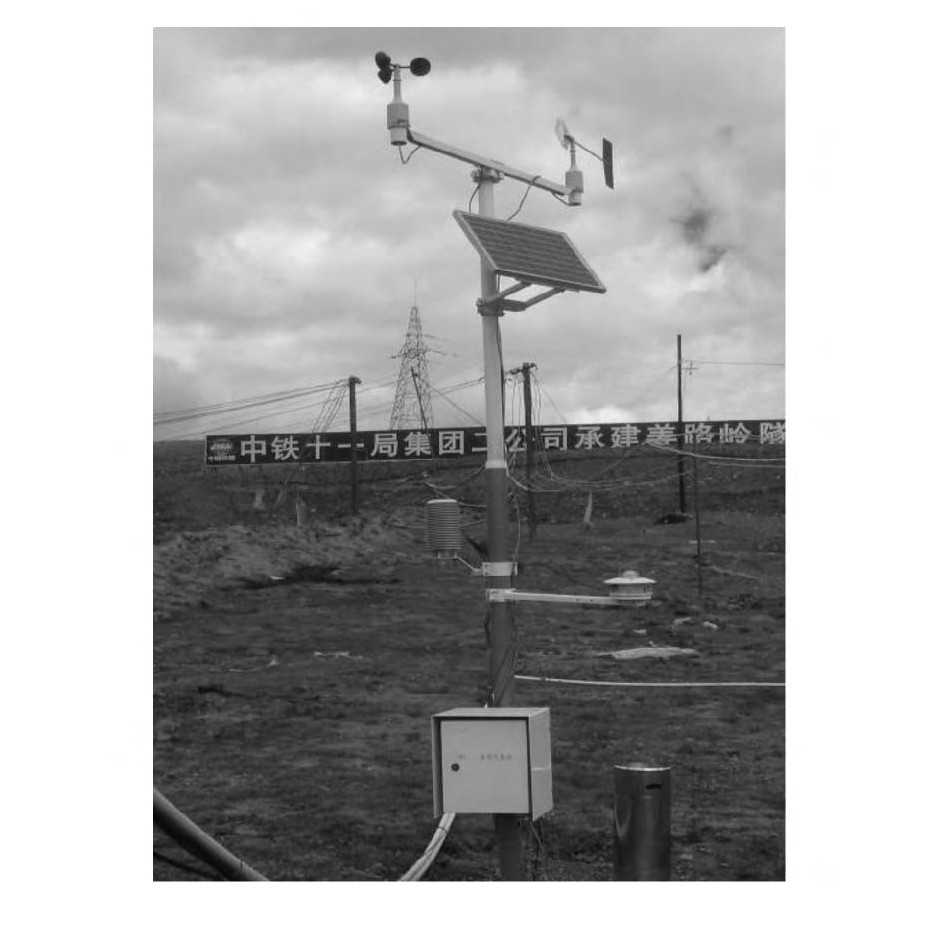Service performance prediction model of tunnel structure in alpine freezing-thawing environment
-
摘要: 为分析高寒大温差冻融环境对公路隧道衬砌结构长期服役性能的影响, 采用现场测试方法得到了姜路岭隧道洞口温度变化规律, 基于室内冻融循环试验拟合了冻融环境下衬砌混凝土力学性能劣化计算公式, 应用荷载结构法建立了高寒冻融环境下衬砌结构服役性能的时空预测模型。研究结果表明: 铺设厚度为5cm、导热系数为0.03 W·(m·℃)-1的保温层后, 姜路岭隧道1年内经历的等效室内冻融循环次数从8下降为0.32;无保温层且混凝土饱水条件下, 5、10、15、20年后拱脚处截面安全系数相对于刚服役时分别降低了0.6%、23.7%、41.1%、69.8%, 二次衬砌服役20年后安全系数已不能满足结构承载的要求; 铺设厚度为5cm、导热系数为0.03 W·(m·℃)-1的保温层后, 二次衬砌服役100年后安全系数仍能够满足承载要求。可见冻融循环的剧烈程度对衬砌结构长期服役性能影响显著, 保温层能有效改善混凝土的冻融环境。Abstract: In order to analyze the influence of alpine freezing-thawing environment with large temperature difference on the long-term service performance of highway tunnel lining structure, the temperature variation law of Jiangluling Tunnel portal was obtained by field test method, the calculation formula for the mechanical property deterioration of lining concrete in freezingthawing environment was obtained based on indoor freezing-thawing cycle test, and the load structure method was used to establish the spatial and temporal prediction model of service performance for lining structure in alpine freezing-thawing environment. Research result shows that after the insulation layer with the thickness of 5cm and the thermal conductivity of 0. 03W·(m·℃)-1 is laid, the number of equivalent indoor freezing-thawing cycles for Jiangluling Tunnel in one year decreases from 8to 0.32. When there is no insulation layer and concrete is saturated, 5, 10, 15, 20 years later, the safety coefficients of arch foot section respectively decrease by 0.6%, 23.7%, 41.1%, 69.8% compared to the original service time. After 20 years of service, the safety coefficient of second lining cannot meet structure load requirement. After the insulation layerwith the thickness of 5cm and the thermal conductivity of 0.03W·(m·℃)-1is laid, the safety coefficient of second lining still meet the load requirement after 100 years of service. The severe degree of freezing-thawing cycles has significant influence on the long-term service performance of lining structure, and the insulation layer can effectively improve the freezing-thawing environment of concrete.
-
表 1 冻融循环温度统计
Table 1. Temperature statistics of freezing-thawing cycles

表 2 有保温层时的冻融参数
Table 2. Freezing-thawing parameters with insulation layer

表 3 物理力学参数
Table 3. Physical and mechanical parameters

表 4 无保温层时二次衬砌混凝土的力学性能
Table 4. Mechanical properties of second lining concrete without insulation layer

表 5 有保温层时二次衬砌混凝土的力学性能
Table 5. Mechanical properties of second lining concrete with insulation layer

表 6 荷载计算结果
Table 6. Load calculation result

表 7 荷载分担比例
Table 7. Load sharing ratios

表 8 钢筋混凝土结构的强度安全系数
Table 8. Strength safety coefficients of reinforced concrete structure

表 9 无保温层时二次衬砌的轴力与弯矩
Table 9. Axial forces and bending moments of second lining without insulation layer

表 10 无保温层时二次衬砌的安全系数
Table 10. Safety coefficients of second lining without insulation layer

表 11 有保温层时二次衬砌的轴力与弯矩
Table 11. Axial forces and bending moments of second lining with insulation layer

表 12 有保温层时二次衬砌的安全系数
Table 12. Safety coefficients of second lining with insulation layer

-
[1] COLLINS A R. The destruction of concrete by frost[J]. Journal of the Institution of Civil Engineers, 1944, 23(1): 29-41. doi: 10.1680/ijoti.1944.14086 [2] LITVAN G G. Frost action in cement paste[J]. Materials and Structures, 1973, 6(4): 293-298. [3] PENTTALA V, AL-NESHAWY F. Stress and strain state of concrete during freezing and thawing cycles[J]. Cement and Concrete Research, 2002, 32(9): 1407-1420. doi: 10.1016/S0008-8846(02)00785-8 [4] CAI H, LIU X. Freeze-thaw durability of concrete: ice formation process in pores[J]. Cement and Concrete Research, 1998, 28(9): 1281-1287. doi: 10.1016/S0008-8846(98)00103-3 [5] SHANG H S, SONG Y P. Experimental study of strength and deformation of plain concrete under biaxial compression after freezing and thawing cycles[J]. Cement and Concrete Research, 2006, 36(10): 1857-1864. doi: 10.1016/j.cemconres.2006.05.018 [6] HASAN M, UEDA T, SATO Y. Stress-strain relationship of frost-damaged concrete subjected to fatigue loading[J]. Journal of Materials in Civil Engineering, 2008, 20(1): 37-45. doi: 10.1061/(ASCE)0899-1561(2008)20:1(37) [7] PHEERAPHAN T, LEUNG C K Y. Freeze-thaw durability of microwave cured air-entrained concrete[J]. Cement and Concrete Research, 1997, 27(3): 427-435. doi: 10.1016/S0008-8846(97)00014-8 [8] 覃丽坤, 宋玉普, 陈浩然, 等. 冻融循环对混凝土力学性能的影响[J]. 岩石力学与工程学报, 2005, 24(增1): 5048-5053. https://cdmd.cnki.com.cn/Article/CDMD-10700-1018835323.htmQIN Li-kun, SONG YU-pu, CHEN Hao-ran, et al. Influence of freezing and thawing cycles on mechanical properties of concrete[J]. Chinese Journal of Rock Mechanics and Engineering, 2005, 24(S1): 5048-5053. (in Chinese). https://cdmd.cnki.com.cn/Article/CDMD-10700-1018835323.htm [9] 曹大富, 富立志, 杨忠伟, 等. 冻融循环下砼力学性能与相对动弹性模量关系[J]. 江苏大学学报: 自然科学版, 2012, 33(6): 721-725. doi: 10.3969/j.issn.1671-7775.2012.06.019CAO Da-fu, FU Li-zhi, YANG Zhong-wei, et al. Relationship between mechanical properties and relative dynamic elasticity modulus of concrete after freeze-thaw cycles[J]. Journal of Jiangsu University: Natural Science Edition, 2012, 33(6): 721-725. (in Chinese). doi: 10.3969/j.issn.1671-7775.2012.06.019 [10] 曹秀丽, 曹志翔, 喻骁. 冻融循环对混凝土质量损失及相对动弹模量影响的试验研究[J]. 铁道建筑, 2013(3): 125-127. doi: 10.3969/j.issn.1673-1816.2013.03.026CAO Xiu-li, CAO Zhi-xiang, YU Xiao. Test research on influence of freeze-thaw cycle to concrete quality loss and relative dynamic elastic modulus[J]. Railway Engineering, 2013(3): 125-127. (in Chinese). doi: 10.3969/j.issn.1673-1816.2013.03.026 [11] 覃丽坤, 宋玉普, 陈浩然, 等. 双轴拉压混凝土在冻融循环后的力学性能及破坏准则[J]. 岩石力学与工程学报, 2005, 24(10): 1740-1745. doi: 10.3321/j.issn:1000-6915.2005.10.018QIN Li-kun, SONG Yu-pu, CHEN Hao-ran, et al. Mechanical property and failure criterion of concrete under biaxial tension and compression after freeze-thaw cycling[J]. Chinese Journal of Rock Mechanics and Engineering, 2005, 24(10): 1740-1745. (in Chinese). doi: 10.3321/j.issn:1000-6915.2005.10.018 [12] 唐光普, 刘西拉, 施士升. 冻融条件下混凝土破坏面演化模型研究[J]. 岩石力学与工程学报, 2006, 25(12): 2572-2578. doi: 10.3321/j.issn:1000-6915.2006.12.026TANG Guang-pu, LIU Xi-la, SHI Shi-sheng. Evolution model of concrete failure surface under freeze-thaw condition[J]. Chinese Journal of Rock Mechanics and Engineering, 2006, 25(12): 2572-2578. (in Chinese). doi: 10.3321/j.issn:1000-6915.2006.12.026 [13] 罗彦斌, 陈建勋, 段献良. C20喷射混凝土冻融力学试验[J]. 中国公路学报, 2012, 25(5): 113-119. doi: 10.3969/j.issn.1001-7372.2012.05.018LUO Yan-bin, CHEN Jian-xun, DUAN Xian-liang. Mechanical testing on frozen-thawy C20shotcrete[J]. China Journal of Highway and Transport, 2012, 25(5): 113-119. (in Chinese). doi: 10.3969/j.issn.1001-7372.2012.05.018 [14] 董长松, 张晓旭, 张弛, 等. 多年冻土区隧道衬砌混凝土冻融循环试验研究[J]. 公路, 2015(11): 244-247. https://www.cnki.com.cn/Article/CJFDTOTAL-GLGL201511053.htmDONG Chang-song, ZHANG Xiao-xu, ZHANG Chi, et al. Test and research on freeze-thaw cycle of tunnel lining concrete in permafrost regions[J]. Highway, 2015(11): 244-247. (in Chinese). https://www.cnki.com.cn/Article/CJFDTOTAL-GLGL201511053.htm [15] 项伟, 刘珣. 冻融循环条件下岩石-喷射混凝土组合试样的力学特性试验研究[J]. 岩石力学与工程学报, 2010, 29(12): 2510-2521. https://www.cnki.com.cn/Article/CJFDTOTAL-YSLX201012020.htmXIANG Wei, LIU Xun. Experimental study of mechanical properties of combined specimen with rock and shotcrete under freezing-thawing cycles[J]. Chinese Journal of Rock Mechanics and Engineering, 2010, 29(12): 2510-2521. (in Chinese). https://www.cnki.com.cn/Article/CJFDTOTAL-YSLX201012020.htm [16] 夏才初, 范东方, 韩常领. 寒区隧道不同类型冻土段隔热(保温)层铺设厚度计算方法[J]. 中国公路学报, 2013, 26(5): 131-139. doi: 10.3969/j.issn.1001-7372.2013.05.018XIA Cai-chu, FAN Dong-fang, HAN Chang-ling. Piecewise calculation method for insulation layer thickness in cold region tunnels[J]. China Journal of Highway and Transport, 2013, 26(5): 131-139. (in Chinese). doi: 10.3969/j.issn.1001-7372.2013.05.018 [17] 姚红志, 张晓旭, 董长松, 等. 多年冻土区公路隧道保温隔热层铺设方式及材料性能对比分析[J]. 中国公路学报, 2015, 28(12): 106-113. doi: 10.3969/j.issn.1001-7372.2015.12.015YAO Hong-zhi, ZHANG Xiao-xu, DONG Chang-song, et al. Comparison analysis on heat insulating material and laying way of highway tunnel in permafrost regions[J]. China Journal of Highway and Transport, 2015, 28(12): 106-113. (in Chinese). doi: 10.3969/j.issn.1001-7372.2015.12.015 [18] 夏才初, 范东方, 李志厚, 等. 隧道多年冻土段隔热层厚度解析计算结果的探讨[J]. 土木工程学报, 2015, 48(2): 118-124. https://www.cnki.com.cn/Article/CJFDTOTAL-TMGC201502018.htmXIA Cai-chu, FAN Dong-fang, LI Zhi-hou, et al. Discussion on analytical calculation for thermal-insulation layer thickness of tunnel in permafrost area[J]. China Civil Engineering Journal, 2015, 48(2): 118-124. (in Chinese). https://www.cnki.com.cn/Article/CJFDTOTAL-TMGC201502018.htm [19] 刘西拉, 唐光普. 现场环境下混凝土冻融耐久性预测方法研究[J]. 岩石力学与工程学报, 2007, 26(12): 2412-2419. doi: 10.3321/j.issn:1000-6915.2007.12.005LIU Xi-la, TANG Guang-pu. Research on prediction method of concrete freeze-thaw durability under field environments[J]. Chinese Journal of Rock Mechanics and Engineering, 2007, 26(12): 2412-2419. (in Chinese). doi: 10.3321/j.issn:1000-6915.2007.12.005 [20] LAI Y M, WU Z, ZHU Y, et al. Nonlinear analysis for the coupled problem of temperature and seepage fields in cold regions tunnels[J]. Cold Regions Science and Technology, 1999, 29(1): 89-96. doi: 10.1016/S0165-232X(99)00006-3 [21] LAI Yuan-ming, LIU Song-yu, WU Zi-wang, et al. Approximate analytical solution for temperature fields in cold regions circular tunnels[J]. Cold Regions Science and Technology, 2002, 34(1): 43-49. doi: 10.1016/S0165-232X(01)00050-7 [22] TOUTAIN J, BATTAGLIA J L, PRADERE C, et al. Numerical inversion of Laplace transform for time resolved thermal characterization experiment[J]. Journal of Heat Transfer, 2011, 133(4): 1-3. [23] HAJI-SHEIKH A, BECK J V. Temperature solution in multidimensional multi-layer bodies[J]. International Journal of Heat and Mass Transfer, 2002, 45(9): 1865-1877. doi: 10.1016/S0017-9310(01)00279-4 [24] SINGH S, JAIN P K, UDDIN R. Finite integral transform method to solve asymmetric heat conduction in a multilayer annulus with time-dependent boundary conditions[J]. Nuclear Engineering and Design, 2011, 241(1): 144-154. doi: 10.1016/j.nucengdes.2010.10.010 [25] 赖远明, 吴紫汪, 张淑娟, 等. 寒区隧道保温效果的现场观察研究[J]. 铁道学报, 2003, 25(1): 81-86. https://www.cnki.com.cn/Article/CJFDTOTAL-TDXB200301017.htmLAI Yuan-ming, WU Zi-wang, ZHANG Shu-juan, et al. Insitu observed study for effect of heat preservation in cold regions tunnels[J]. Journal of the China Railway Society, 2003, 25(1): 81-86. (in Chinese). https://www.cnki.com.cn/Article/CJFDTOTAL-TDXB200301017.htm [26] 夏才初, 张国柱, 肖素光. 考虑衬砌和隔热层的寒区隧道温度场解析解[J]. 岩石力学与工程学报, 2010, 29(9): 1767-1773. https://www.cnki.com.cn/Article/CJFDTOTAL-YSLX201009005.htmXIA Cai-chu, ZHANG Guo-zhu, XIAO Su-guang. Analytical solution to temperature fields of tunnel in cold region considering lining and insulation layer[J]. Chinese Journal of Rock Mechanics and Engineering, 2010, 29(9): 1767-1773. (in Chinese). https://www.cnki.com.cn/Article/CJFDTOTAL-YSLX201009005.htm [27] 安光明, 杨球玉, 杨立建, 等. 某核电厂岩体动静弹性模量的对比研究[J]. 岩土力学, 2011, 32(增1): 565-569. https://www.cnki.com.cn/Article/CJFDTOTAL-YTLX2011S1100.htmAN Guang-ming, YANG Qiu-yu, YANG Li-jian, et al. Comparison between static and dynamic elastic moduli of rock mass in a nuclear power plant[J]. Rock and Soil Mechanics, 2011, 32(S1): 565-569. (in Chinese). https://www.cnki.com.cn/Article/CJFDTOTAL-YTLX2011S1100.htm -





 下载:
下载:







